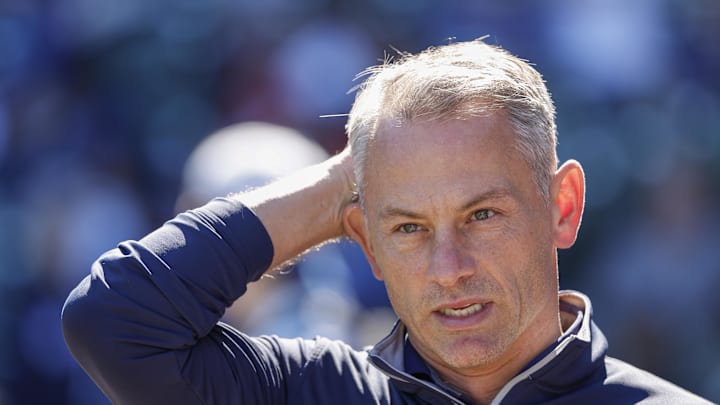Jed Hoyer/Carter Hawkins front office WAA impact on Chicago Cubs: -5.5 games. Rank in MLB: 25. Rank in division: 3.
With the team’s late-season collapse fresh in fans’ minds, a lot of blame is being assigned for the failure of the 2023 Chicago Cubs to claim a postseason spot.
Several players have been cited by name for the team’s desultory finish, which saw Chicago lose 15 of its final 22 games to fall one game short. Christopher Morel, Dansby Swanson, Jameson Taillon and Patrick Wisdom have been cited by name, as has the entire Cubs bullpen.
Field manager David Ross also comes in for regular blame for his failure to stem the prolonged collapse.
Most of those post-mortems, however, fail to assign blame to the one element of the Cubs that deserves the biggest share of responsibility. That element is the front office, and specifically team president Jed Hoyer and general manager Carter Hawkins.
They are the ones who made the personnel decisions that got the Cubs into the late-season mess they were in.
Indeed, the post mortems have largely praised Hoyer and Hawkins for their trade deadline willingness to forego calls to trade away the team’s two most negotiable assets, slugger Cody Bellinger and starter Marcus Stroman. It took guts to stay with both, and while Stroman was an injury-riddled bust over the season’s final two months Bellinger nearly lifted the team to October baseball.
You’ll get no post-mortem criticism here for either of those two non-decisions. They tried; it didn’t work; move on.
But Hoyer and Hawkins do deserve blame for many of the other often overlooked personnel decisions they made impacting the fate of the 2023 Cubs. They were, by and large bad decisions.
Collectively, Hoyer, Hawkins and the team’s front office made 42 personnel moves directly affecting major league rosters since the end of the 2022 postseason. You can think of those moves as the front office’s short-term impact on team performance.
A couple of those 42 moves, notably the free agent signings of Bellinger and Swanson, got very favorable reviews. The problem was the other 40 less publicized personnel moves. Despite the 5.5 game head start provided by the Bellinger and Swanson signings, the overall short-term impact of all 42 decisions on the Cubs’ 2023 fate — as measured by the net Wins Above Average impact of those moves — was a condemnatory -5.5 games.
WAA is used in this series of front office evaluations because it is a zero-based version of WAR, therefore enabling valid approximations of impact against wins and losses.
Here are the worst.
1. Seeking veteran production at first base, the Cubs signed the tandem of Trey Mancini and Eric Hosmer over the winter. Both bombed. Mancini batted just .234 with no power before being released in early August. Hosmer, who also hit .234 with no power, didn’t even last that long. Still, their collective impact on team fortunes measured out to -3.1 games.
2. The front office let catcher Willson Contreras walk to St. Louis, where he was a beacon during a miserable season in North Siders’ least favorite city. Yes, there were defensive issues. Still Contreras delivered a 124 OPS+. With Contreras gone, the Cubs committed to the platoon of Yan Gomes and Tucker Barnhart behind the plate. Barnhart failed to hold up his end of the bargain, batting just .202 with no power before being released in August.
3. They signed free agent Jameson Taillon for four years at $68 million. Taillon responded with an 8-10 record and 4.84 ERA in 29 tarts spanning 154 innings. That worked out to -1.5 games of WAA.
4. They re-signed Drew Smyly, coming off a 7-8, 3.47 2022 season. In 23 starts that devolved into 18 relief appearances, Smyly went 11-11 with a 5.00 ERA, in the process costing the team another -1.2 games of WAA.
None of those moves were as highly scrutinized as the signings of Bellinger and Swanson, but collectively they impacted the team by -9.2 games. You want to know where to put the blame for the Cubs’ 2023 shortcomings? Follow the data.
Here’s the short-term and long-term statistical profile on the 2023 performance of the Hoyer-Hawkins front office. All figures reflect net Wins Above Average
Acquired by trade, waiver claim or purchase
- Since October 2022: 6 players, 0.0 net impact
- Prior to October 2023: 1 player, -0.5 net impact
Signed as a free agent or extended for multiple seasons
- Since October 2022: 16 players, -1.0 net impact
- Prior to October 2022: 3 players, +1.6 net impact
System products
- Since October 2022: 11 players, +0.2 net impact
- Prior to October 2022: 5 players, -1.0 net impact
Traded away, waived, sold, released or lost to free agency
- Since October 2022: 12 players, +3.8 net impact
- Prior to October 2022: 12 players, -0.5 net impact
The sum of all that positive and negative roster movement on team fortunes works out to -5.5 games of short-term impact offset by only one-half game of positive long term impact. The Cubs failed to reach the postseason by the margin of one game.
Based on the data, the Cubs front office was the second of only two this season — along with the San Francisco Giants — who committed the cardinal sin of maneuvering their team out of postseason play.
